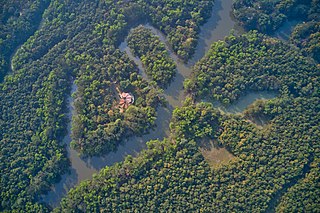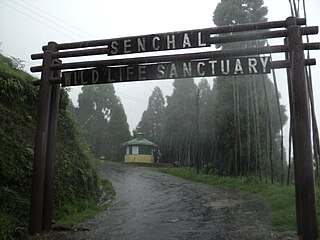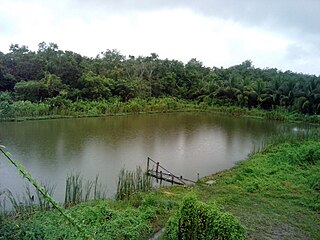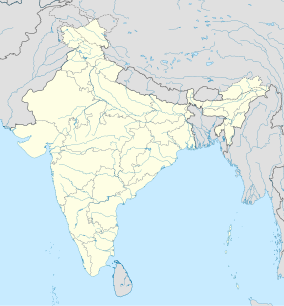
The Chota Nagpur Plateau is a plateau in eastern India, which covers much of Jharkhand state as well as adjacent parts of Chhattisgarh, Odisha, West Bengal and Bihar. The Indo-Gangetic plain lies to the north and east of the plateau, and the basin of the Mahanadi river lies to the south. The total area of the Chota Nagpur Plateau is approximately 65,000 square kilometres (25,000 sq mi).

Mahananda Wildlife Sanctuary is located on the foothills of the Himalayas, between the Teesta and Mahananda rivers. Situated in the Darjeeling district of West Bengal, India; it comes under Darjeeling Wildlife division and can be reached from Siliguri in 30 minutes. Sukna, the gateway to the sanctuary, is only 13 km from Siliguri and 28 km from Bagdogra airport. The sanctuary sprawls over 159 km2 of reserve forest and was started as a game sanctuary in 1955. In 1959, it got the status of a sanctuary mainly to protect the Indian bison and royal Bengal tiger, which were facing the threat of extinction.

The Sundarbans National Park is a national park, tiger reserve and biosphere reserve in West Bengal, India. It is part of the Sundarbans on the Ganges Delta and adjacent to the Sundarban Reserve Forest in Bangladesh. It is located to south-west of the Bangladesh. The delta is densely covered by mangrove forests, and is one of the largest reserves for the Bengal tiger. It is also home to a variety of bird, reptile and invertebrate species, including the salt-water crocodile. The present Sundarban National Park was declared as the core area of Sundarban Tiger Reserve in 1973 and a wildlife sanctuary in 1977. On 4 May 1984 it was declared a national park. It is a UNESCO World Heritage Site inscribed in 1987, and it has been designated as a Ramsar site since 2019. It is considered as a World Network of Biosphere Reserve from 1989.

Sundarbans is a mangrove area in the delta formed by the confluence of the Ganges, Brahmaputra and Meghna Rivers in the Bay of Bengal. Sundarban Reserve Forest (SRF) of Bangladesh is the largest mangrove forest in the world. It spans the area from the Baleswar River in Bangladesh's division of Khulna to the Hooghly River in India's state of West Bengal. It comprises closed and open mangrove forests, land used for agricultural purpose, mudflats and barren land, and is intersected by multiple tidal streams and channels. Sundarbans is home to the world's largest area of mangrove forests. Four protected areas in the Sundarbans are enlisted as UNESCO World Heritage Sites, viz. Sundarbans West (Bangladesh), Sundarbans South (Bangladesh), Sundarbans East (Bangladesh) and Sundarbans National Park (India).

Jaldapara National Park is a national park situated at the foothills of the Eastern Himalayas in Alipurduar District of northern West Bengal, India, and on the banks of the Torsa River. Jaldapara is situated at an altitude of 61 m and is spread across 216.51 km2 (83.59 sq mi) of vast grassland with patches of riverine forests. It was declared a sanctuary in 1941 for protection of its great variety of flora and fauna.

The Eastern Highlands moist deciduous forests, presently known as East Deccan moist deciduous forests, is a tropical and subtropical moist broadleaf forests ecoregion in east-central India. The ecoregion covers an area of 341,100 square kilometers (131,700 sq mi), extending across portions of Andhra Pradesh, Chhattisgarh, Jharkhand, Madhya Pradesh, Maharashtra, Odisha, and Telangana states.

The Lower Gangetic Plains moist deciduous forests is a tropical and subtropical moist broadleaf forests ecoregion of Bangladesh and India. The ecoregion covers an area of 254,100 square kilometres (98,100 sq mi), comprising most of Bangladesh and the Indian states of West Bengal, Bihar and Tripura, and extending into adjacent states of Odisha, Uttar Pradesh and a tiny part of Assam, as well as adjacent western Myanmar.

Chapramari Wildlife Sanctuary is close to the Gorumara National Park. Chapramari is about 30 kilometres from Chalsa and Lataguri in northern West Bengal, India. The total coverage of the forest is 960 hectares.

The Himalayan subtropical broadleaf forests is an ecoregion that extends from the middle hills of central Nepal through Darjeeling into Bhutan and also into the Indian States of Uttar Pradesh and Bihar. It represents the east–west-directed band of subtropical broadleaf forest at an altitude of between 500 and 1,000 m along the Outer Himalayan Range, and includes several forest types traversing an east to west moisture gradient.

Senchal Wildlife Sanctuary was set up in 1915 in the Darjeeling District of West Bengal, India.

Bethuadahari Wildlife Sanctuary is situated in the Bethuadahari town of Nadia District, West Bengal, India. The sanctuary is located beside National Highway 12. The sanctuary covers 67 hectares, and was established in 1980 to preserve a portion of the central Gangetic alluvial zone.

Bibhutibhusan Wildlife Sanctuary is an animal sanctuary in North 24 Parganas district in the Indian state of West Bengal. The forest is located about 100 km from Kolkata and 25 km from Bongaon.
Ramnabagan Wildlife Sanctuary is in Bardhaman, West Bengal, India. The animals found include spotted deer and common langur.
Sajnekhali Wildlife Sanctuary is a 362 km2 area in the northern part of the Sundarbans delta in South 24 Parganas district, West Bengal, India. It is located at the confluence of the Matla and Gumdi rivers. The area is mainly mangrove scrub, forest and swamp. It was set up as a sanctuary in 1976. It is home to a rich population of different species of wildlife, such as water fowl, heron, pelican, spotted deer, rhesus macaques, wild boar, tigers, water monitor lizards, fishing cats, otters, Olive ridley turtle, crocodiles, Batagur terrapins, and migratory birds. The ideal place for nature lovers to observe wild animals from a height is the Sajnekhali Watchtower.
The Haliday Island Wildlife Sanctuary is one of several wildlife sanctuaries in the nation of India. Located in the state of West Bengal, the area is approximately six square kilometers in size. It is a part of the 'Sundarbans Biosphere Reserve', with the Sundarbans region as a whole becoming a 'Biosphere Reserve' officially in 1989. The wildlife-heavy areas there are regarded as an environmentally-minded tourist destination.

Sundarbans South Wildlife Sanctuary is a reserve forest in Bangladesh that extends over an area of 36,970 hectares of mangrove forest. It is situated next to the Sundarbans National Park in West Bengal, India. The sanctuary is one of three Sundarbans wildlife sanctuaries, the others being the Sundarbans East Wildlife Sanctuary and the Sundarbans West Wildlife Sanctuary.

Sundarbans West Wildlife Sanctuary is a UNESCO World Heritage Site and animal sanctuary in Bangladesh. The area of the reserve covers 715 km2. It is part of the larger Sundarbans region, one of the largest mangroveforests in the world. It is formed at the unified delta of the Ganges, Brahmaputra and Meghna rivers on the Bay of Bengal. The total area of the entire Sundarbans is about one million ha, 60% of which is found in Bangladesh, with the remainder 40% in India. The region is divided by the Raimangal River. Within the Bangladeshi area of Sundarbans, there are three wildlife sanctuaries: Sundarbans East, Sundarbans South, and Sundarbans West.
Pangolakha Wildlife Sanctuary is a wildlife reserve in the Pakyong District of the state of Sikkim in India. It is about 28 kilometres (17 mi) east of Rorathang and about 40 kilometres (25 mi) by road from Rangpo city. The total notified area of the park is around 124 square kilometres (48 sq mi) while inside the wildlife sanctuary there are a few hamlets: Aritar, Dakline Lingtam, Phadamchen, Dzuluk, Gnathang Monastery Kupup. This wildlife sanctuary is linked to the forests of Neora Valley National Park of West Bengal as well as forests of Samtse, Bhutan and Haa district Bhutan. The area that comes under this biosphere has been declared in 1999 as a wildlife sanctuary under biogeographic province category 2C.















